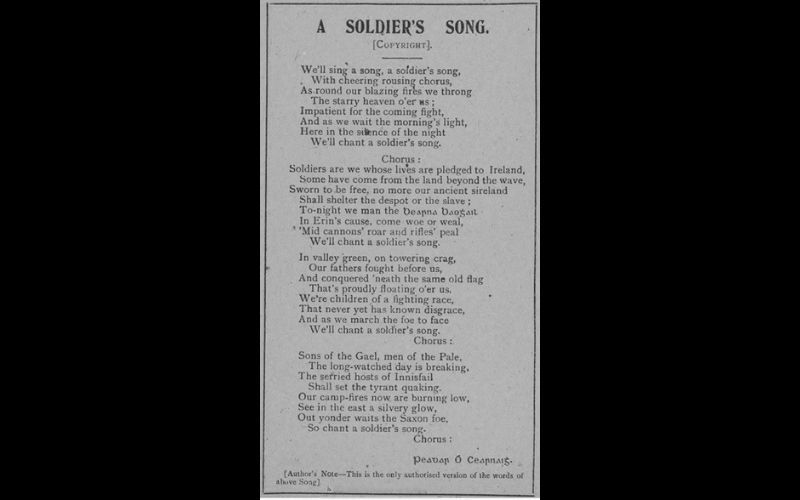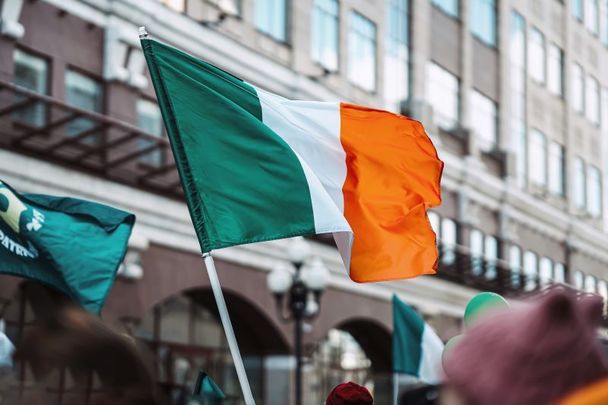"Amhrán na bhFiann" ("The Soldier's Song," in English) has been the official national anthem of the Irish State for almost 100 years, but what are the origins of the famous song?
Written by Peader Kearney in 1909, "Amhrán na bhFiann" was originally written in English and consisted of three verses, with music composed by Kearney's friend Patrick Heeney.
It first appeared in the magazine Irish Freedom in 1912 and rose to prominence during Ireland's struggle for independence, with rebels singing it in the GPO during the 1916 Easter Rising.
It is hardly surprising that the song rose to popularity during Ireland's struggle for independence, considering its lyrics call for the triumph of the slave over the despot.
One verse calls for Irish people to "set the tyrant quaking," describing English forces as the "Saxon foe."

Lyrics to "A Soldier's Song" by Peadar Kearney, circa 1916. (Public Domain / Trinity College Dublin)
It rose in popularity again among the rebels imprisoned at the Frongoch internment camp in Wales following the Rising and became even more popular during the subsequent Irish War of Independence between 1919 and 1921, becoming known as the "Sinn Féin Anthem."
Irish historian Donal Ó Drisceoil notes that the British Army confiscated copies of the song during the War of Independence as they viewed it as seditious and likely to incite rebellion.
During the Civil War, the song remained popular among both Free State soldiers and anti-treaty IRA volunteers, while it remained a popular military tune following the conclusion of the Civil War and was regularly played at Army functions.
"The Soldier's Song" was officially translated into Irish by Liam Ó Rinn in 1923, although Ó Rinn may have started working on the Irish translation as early as 1916 when he was interned at Frongoch.
However, it was not immediately adopted as Ireland's official anthem when Ireland won independence from Britain in 1922.
Wishing to avoid political controversy, WT Cosgrave, the first Taoiseach of the Irish Free State, avoided making "The Soldier's Song" Ireland's official anthem out of fear of isolating the unionist community in Northern Ireland, according to cultural historian Dr. Karol Mullaney Dignam.
In the early days of the Irish Free State, therefore, the song remained Ireland's unofficial anthem.
However, concern arose over a lack of an official anthem for the Irish Free State, which gave unionists in Ireland an opportunity to persist with "God Save the King" as Ireland's unofficial anthem.
On July 12, 1926, the Executive Council of the Irish Free State officially adopted "Amhrán na bhFiann" as Ireland's national anthem.

Love Irish history? Share your favorite stories with other history buffs in the IrishCentral History Facebook group.
"Amhrán na bhFiann" lyrics (Irish)
Sinne Fianna Fáil,
atá faoi gheall ag Éirinn,
Buíon dár slua
thar toinn do ráinig chugainn,
Faoi mhóid bheith saor
Seantír ár sinsear feasta,
Ní fhágfar faoin tíorán ná faoin tráill.
Anocht a théam sa bhearna bhaoil,
Le gean ar Ghaeil, chun báis nó saoil,
Le gunna-scréach faoi lámhach na bpiléar,
Seo libh canaig' amhrán na bhFiann.
"The Soldier's Song" lyrics (English)
Soldiers are we,
whose lives are pledged to Ireland,
Some have come
from a land beyond the wave,
Sworn to be free,
no more our ancient sireland,
Shall shelter the despot or the slave.
Tonight we man the bearna bhaoil,
In Erin's cause, come woe or weal,
'Mid cannons' roar and rifles' peal,
We'll chant a soldier's song.




Comments